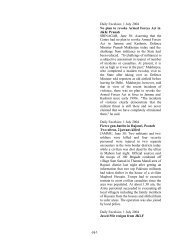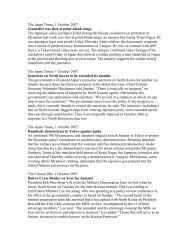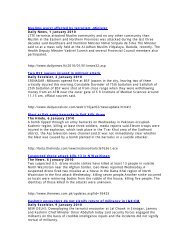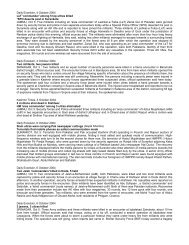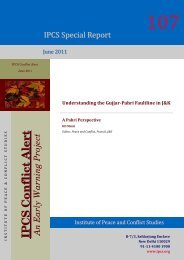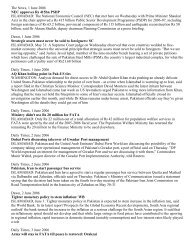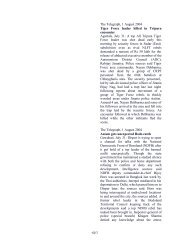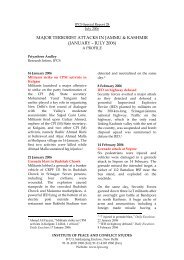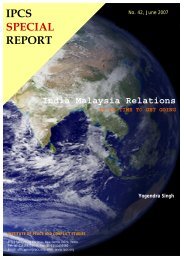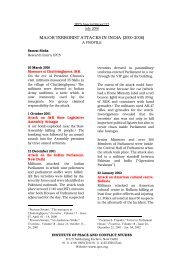April-June 2013 - Institute of Peace and Conflict Studies
April-June 2013 - Institute of Peace and Conflict Studies
April-June 2013 - Institute of Peace and Conflict Studies
Create successful ePaper yourself
Turn your PDF publications into a flip-book with our unique Google optimized e-Paper software.
Commentary<br />
Water <strong>Conflict</strong>s in South Asia: Lessons from the Alwar River Parliament<br />
Roomana Hukil<br />
Research Officer, IReS, IPCS<br />
The much articulated <strong>and</strong> sensationalised meeting <strong>of</strong><br />
November 2012 was unsuccessful to <strong>of</strong>fer respite with<br />
respect to the Cauvery water row between Karnataka <strong>and</strong><br />
Tamil Nadu. As envisaged, the Chief Ministers <strong>of</strong> both states<br />
were incompetent in addressing the principle theme <strong>of</strong> the<br />
meeting – to discuss the issue within the larger context <strong>of</strong><br />
farmers directly affected by the issue, <strong>and</strong> seeking a final<br />
settlement between both states. For years, regulatory<br />
mechanisms including the Cauvery River Authority (CRA) <strong>and</strong><br />
the Cauvery Water Dispute Tribunal (CWDT) have been unable<br />
to <strong>of</strong>fer either <strong>of</strong> the states any compliance on ruling.<br />
What does the status quo imply for the current plight <strong>of</strong> the<br />
farmers <strong>and</strong> the future course <strong>of</strong> the issue? Is there an existing<br />
model within India or South Asia that could be used as a<br />
template to address the Cauvery Water row? Could the Alwar<br />
River Parliament be considered a suitable case study in the<br />
context <strong>of</strong> the Cauvery, which could look into the possibility <strong>of</strong><br />
establishing a constitutional mechanism for efficient water<br />
governance by both Tamil Nadu <strong>and</strong> Karnataka?<br />
Alwar River Parliaments: A Case Study<br />
Assessing the water paradigm <strong>of</strong> the Arvari River in Rajasthan<br />
in 1985 can help in identifying an excellent example <strong>of</strong><br />
effective resource revival. Before the leadership <strong>of</strong> water<br />
conservationist, Rajender Singh, the Arvari waterway was a<br />
dead river. This was attributed to the mineral extraction <strong>and</strong><br />
logging that had decimated the forestry <strong>of</strong> the region <strong>and</strong><br />
damaged the entire watershed. As a result, the entire<br />
watercourse <strong>and</strong> farml<strong>and</strong> had completely dried up. More so,<br />
floods caused by monsoon rains became perennial; due to<br />
which villagers ab<strong>and</strong>oned their johads or rainwater storage<br />
tanks thus leading to acute water shortages.<br />
In these circumstances, Singh established community-led<br />
institutions in each village in the region; from Gram Sabhas to<br />
Mahila Banks <strong>and</strong> River Parliaments. One <strong>of</strong> the most<br />
successful developments was the introduction <strong>of</strong> the Alwar<br />
River Parliament that was not only garnered in the interest <strong>of</strong><br />
reviving the defunct watercourse, but also to establish<br />
effective water governance that would prevent future crises<br />
from taking place. With a view to meet escalating village<br />
requirements, Rajender Singh initiated rural development<br />
<strong>and</strong> employment generation, whereby integrating water<br />
conservation as his primary motive at Gopalpura village. He<br />
built 8600 johads in 1058 villages spread over 6500 sq.km. Out<br />
<strong>of</strong> these, 3500 were built by the Tarun Bhagat Singh NGO <strong>and</strong><br />
as an aftereffect, the local community was motivated enough<br />
to build the remaining 5100 structures. The area covered<br />
parts <strong>of</strong> the contiguous districts <strong>of</strong> Alwar, Dausa, Sawai<br />
Madhopur, Karoli <strong>and</strong> Jaipur. As a result, five seasonal rivers –<br />
the Ruparel, Arvari, Sarsa, Bhagani <strong>and</strong> Jahajwali – in the<br />
northeast region <strong>of</strong> Rajasthan became perennial.<br />
However, after regenerating the rivers, the Rajasthan state<br />
government gave fishing contracts to locals <strong>and</strong> outsiders in<br />
certain stretches <strong>of</strong> the Arvari River. Singh feared a derailment<br />
in his graph <strong>and</strong> consequently, in order to protect the river<br />
from ill effects, the Arvari River Parliament - a decentralised<br />
power model - was introduced in 72 villages located on the<br />
riverbanks <strong>of</strong> the Arvari River.<br />
The idea <strong>of</strong> the Parliament was to safeguard <strong>and</strong> uphold the<br />
integrated water management efforts <strong>of</strong> the community for<br />
the river catchment. It comprised <strong>of</strong> two representatives from<br />
each village. Till today, it constitutes one <strong>of</strong> the eleven rules<br />
that pertain to the use <strong>of</strong> the river, water management,<br />
extraction or sale <strong>of</strong> the river water, revival <strong>of</strong> traditional<br />
methods for conservation, propagating equitable<br />
distribution, accessibility <strong>of</strong> the water resource, etc. A<br />
coordination committee comprising members selected by the<br />
Parliament h<strong>and</strong>les operations <strong>and</strong> ensures compliance with<br />
the rules. Though this River Parliament has no legal status <strong>and</strong><br />
its decisions are not legally binding, the moral force <strong>of</strong> the<br />
people makes its survival possible.<br />
Cauvery: Lessons from Alwar<br />
In the context <strong>of</strong> the Cauvery River, a marked correlation <strong>of</strong><br />
activities can be vividly drawn from the example <strong>of</strong> the Alwar<br />
River Project. Despite socio-economic, political <strong>and</strong><br />
demographic differences between the two Rivers, certain<br />
achievements still paramount a relationship. Looking at the<br />
current water dynamics <strong>of</strong> the South, establishing a<br />
centralised parliamentary system, solely governed by the<br />
state, may seem to <strong>of</strong>fer some respite. Constitutionally,<br />
recognising such a set-up would ensure equitable distribution<br />
<strong>and</strong> access to waterways.<br />
Water expert, B.G Verghese, advocates the need for<br />
catchment basin management for the Cauvery water dispute.<br />
“One <strong>of</strong> the ways for resolving the Cauvery challenge is by<br />
looking at the Water Parliament models <strong>of</strong> Alwar. The efforts<br />
towards water conservation have had numerous positive<br />
impacts on the communities inhabiting these areas. The<br />
Cauvery issue requires a holistic approach to our water<br />
environment. It is essential to revamp our outmoded systems<br />
<strong>and</strong> look into the intricate fabrics <strong>of</strong> the structure”. As in the<br />
case <strong>of</strong> Alwar, establishing Water Parliaments for the Cauvery,<br />
instituting autonomous state control, pricing river water,<br />
extensively engaging consumer (farmer) participation <strong>and</strong> so<br />
on, are among the few alternatives that look into providing a<br />
sense <strong>of</strong> relief to the issue.<br />
South Asia Plus 9



